If you're just getting started, the best smart home setup usually involves a mix of a few key pieces. Think of an Amazon Echo smart speaker as your central hub, a Google Nest Video Doorbell for security, and a smart thermostat to handle energy efficiency. The trick is to start with a voice assistant and then add a couple of devices that tackle your biggest priorities, whether that's security or just cool lighting.
Welcome to Your Smarter, Simpler Home
Jumping into the world of smart homes can feel a bit like stepping into a sci-fi movie, but it's far more straightforward and affordable than most people realize. Think of this guide as your personal roadmap to building a connected home that genuinely makes your life easier, not more complicated. We're going to break it all down, piece by piece.
Let's imagine your smart devices as a team of specialists. Your voice assistant or a central app is the coach, calling the plays that smooth out your day. It’s the coach that tells the lights to dim for movie night, nudges the thermostat to the perfect temperature right before you get home, or lets you see who's at the front door, even when you're halfway across the world.
What Actually Makes a Home "Smart"?
A truly smart home isn't just about cramming your house full of the latest gadgets. It’s about making practical, meaningful upgrades that solve everyday problems. At its core, it all comes down to two things: automation and remote control. This combination gives you a level of convenience and peace of mind you just can't get otherwise.
This desire for practical convenience has caught on in a big way. The global market for smart home devices was already valued at around USD 81.0 billion in 2025 and is on track to hit a staggering USD 389.8 billion by 2035. That explosive growth isn't just hype; it's a clear sign that people are finding real value in these solutions. You can dig into the numbers in this market research from Future Market Insights.
Most of the best smart home gear falls into a few main categories, each designed to improve a different part of your daily life:
- Smart Security: This includes things like video doorbells and smart locks that let you keep an eye on things and control access from anywhere.
- Smart Lighting: Think bulbs and switches you can control with your voice, set on schedules, and use to create the perfect mood—all while saving a little energy.
- Climate Control: Smart thermostats are the star here, learning your schedule to keep you comfortable while trimming down your heating and cooling bills.
A truly smart home is one that anticipates your needs. It’s not just about barking voice commands; it's about creating an environment that responds to your lifestyle, making daily routines more efficient and your home more secure.
This guide will walk you through the best options in each of these areas, showing you how they all fit together to create a seamless experience. We’ll cut through the tech jargon and focus on what these devices actually do for you, helping you build a smarter home one simple step at a time.
Choosing Your Smart Home Operating System
Before you rush out and buy a single smart gadget, you have to make one crucial decision first. Think of it like picking a side in the smartphone wars: are you an iPhone person or an Android person? Your smart home "operating system" is the exact same kind of choice. It’s the central nervous system that allows all your devices to talk to each other, and it will shape every purchase you make from here on out.
The big three players in this arena are Amazon Alexa, Google Assistant, and Apple HomeKit. Each one has its own personality, its own strengths, and its own quirks. The trick is to figure out which one fits best with the tech you already own and what you want your future smart home to look like.
Amazon Alexa: The Universal Connector
If you want the platform that plays nicely with almost everything, look no further than Amazon Alexa. It's the undisputed king of compatibility, boasting support for tens of thousands of devices. If you can think of a smart gadget, there's a very high chance it works with Alexa.
This makes Alexa the perfect choice if you love having options and want the freedom to mix and match brands. Its strength is its sheer scale and its library of "Skills," which are basically apps that teach Alexa how to control new devices. For anyone who likes to tinker or just wants maximum flexibility, Alexa is tough to beat.
Google Assistant: The Seamless Integrator
For those already living in Google’s world—with Gmail, Google Calendar, and an Android phone—Google Assistant offers an incredibly natural and integrated experience. It taps into the information you already trust Google with to give you genuinely helpful, context-aware answers.
For instance, it can pull your flight details from an email confirmation or tell you about traffic on your way to an appointment from your calendar without you lifting a finger. Google has always been a master of understanding natural, conversational language, and that really shines here. It's the go-to for households that run on Google's services.
Apple HomeKit: The Guardian of Privacy
Apple's entire philosophy is built on a foundation of privacy and security, and Apple HomeKit is the perfect reflection of that. If keeping your personal data under lock and key is your top priority, this is your ecosystem, period.
Apple enforces incredibly strict end-to-end encryption and security protocols for any device that wants to join its network. A lot of the processing happens locally on your own devices, not on a server somewhere in the cloud. While it supports fewer devices than its competitors, any product with the "Works with Apple HomeKit" badge has been through the wringer to get certified. This creates a rock-solid, secure, and reliable system, making it the default choice for anyone deep inside the Apple ecosystem.
Choosing your ecosystem is less about which one is "best" and more about which one is best for you. Consider the devices you already own and love, your comfort level with technology, and your personal priorities—whether that's maximum choice, seamless integration, or airtight security.
To give you a clearer picture, let’s break down how these three giants stack up against each other.
Smart Home Ecosystem Comparison
| Feature | Amazon Alexa | Google Assistant | Apple HomeKit |
|---|---|---|---|
| Best For | Maximum device compatibility and flexibility. | Seamless integration with Google services. | Privacy, security, and Apple users. |
| Device Support | Largest; tens of thousands of devices. | Very large and growing quickly. | Smallest, but highly curated and secure. |
| Voice Assistant | Alexa | Google Assistant | Siri |
| Setup Process | Generally simple via the Alexa app and "Skills". | Straightforward, especially for Android users. | Very easy, often just scanning a QR code. |
| Key Strength | Unmatched third-party hardware support. | Superior natural language understanding. | Industry-leading privacy and security protocols. |
Ultimately, the platform you choose will be the foundation for your entire connected home.
This infographic gives you a quick visual comparison of the flagship speakers from each ecosystem, really driving home the key differences in price and, most importantly, device compatibility.
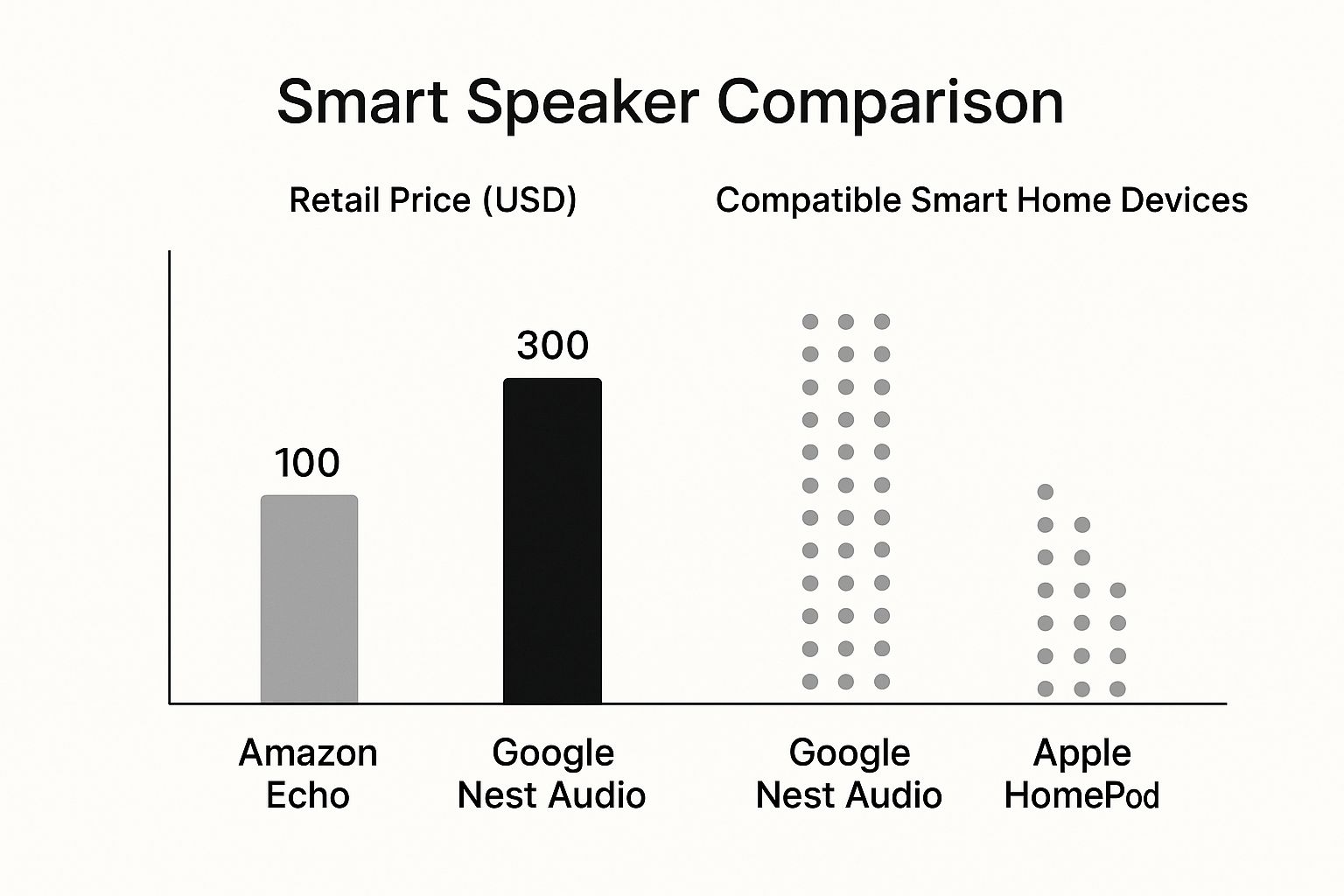
As you can see, Amazon's dominance in raw numbers is clear, highlighting why it’s the go-to for building a diverse smart home. Your choice here sets the stage for everything that comes next, defining how all your smart devices will work—or won't work—together.
Smart Security Devices for Real Peace of Mind
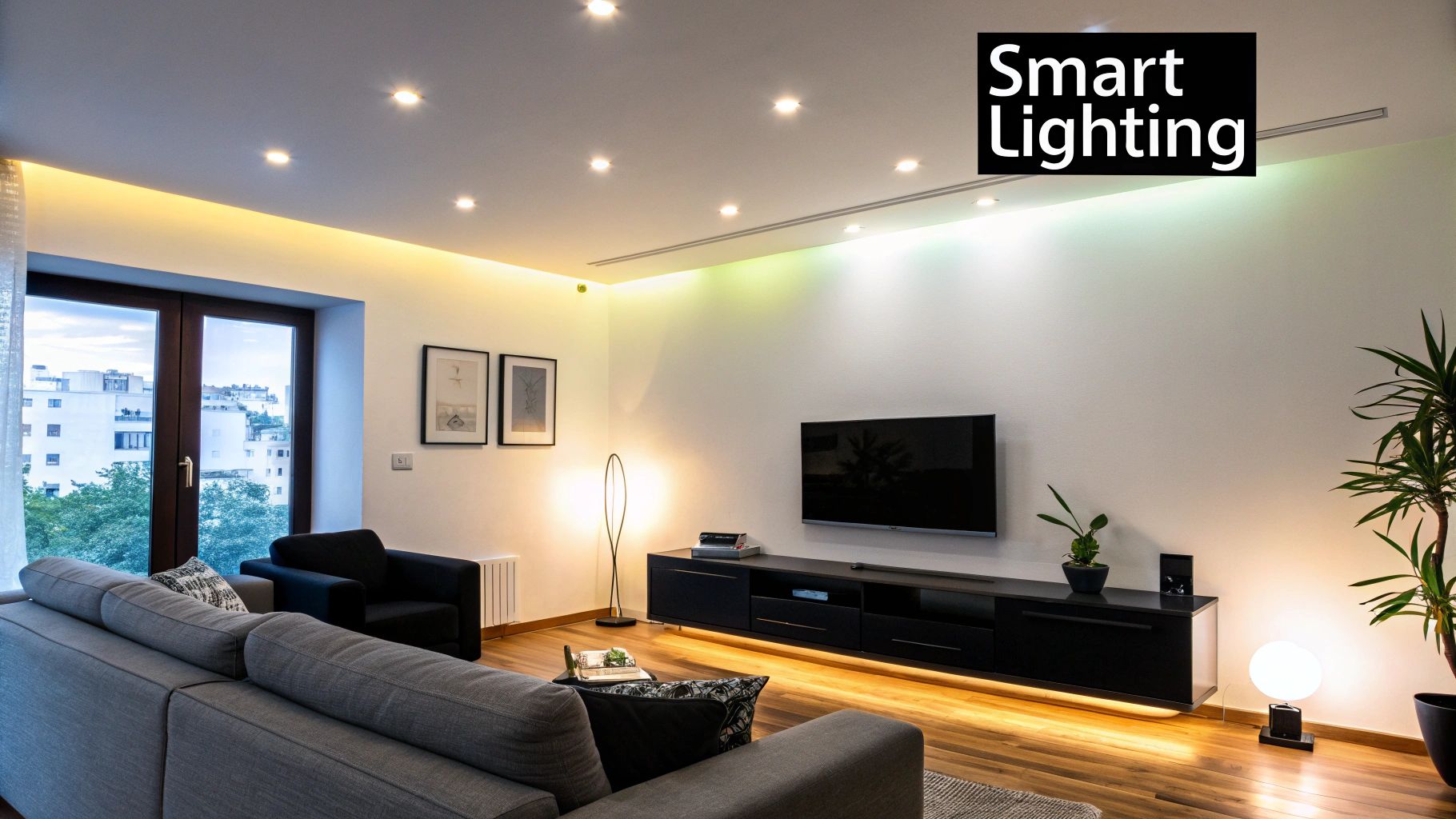
True home security isn't just about a blaring alarm. It's about feeling connected and in control, whether you’re on the couch or halfway around the world. The best smart devices in this category give you that genuine peace of mind by creating a virtual presence right at your doorstep.
Think of your home's security like layers of an onion. The outer layer is your first line of defense, and that's where smart cameras and video doorbells act as your digital gatekeepers. They don't just record things as they happen; they actively help you stop trouble before it starts.
This desire for proactive security is a huge reason the smart home market is exploding. It's projected to hit $149.43 billion in 2025 and is on track to balloon to an incredible $633.2 billion by 2032. Security gadgets are a massive piece of that pie, with their market share expected to grow by 6% in the next seven years.
Video Doorbells: Your Digital Doorman
If you're going to make just one smart home upgrade, a video doorbell gives you the most bang for your buck. It’s a simple idea with a powerful impact: you always know who's at your door before you even think about opening it. This device is your first, and most active, line of defense.
Imagine getting a notification on your phone the instant someone approaches your front steps. You can see a package being delivered, watch the kids get home from school, or even talk to a courier through two-way audio, no matter where you are. That feature alone is a game-changer for stopping package theft.
Top models like the Google Nest Video Doorbell deliver crisp, high-definition video and intelligent alerts that can actually tell the difference between a person, a package, or a car. It completely transforms your entryway from a passive door into an active, monitored security point.
Smart Cameras: Keeping a Watchful Eye
While a doorbell guards the front, smart cameras extend that protection to every other corner of your property. Forget the grainy, unreliable security footage of the past. Today's smart cameras offer crystal-clear video, impressive night vision, and smart features that make monitoring your home ridiculously easy.
Think strategically about where to place them:
- Driveways and Garages: To keep tabs on vehicles and major access points.
- Backyards and Patios: To watch over vulnerable spots like sliding glass doors.
- Indoor Common Areas: Great for checking in on pets or just making sure the house is empty.
Many of the best smart cameras are now completely wireless, so you can stick them just about anywhere without drilling holes or running cables. They send you customized alerts, which means you're only notified about things that actually matter—not every time a squirrel runs across the lawn.
Your smart security system should work for you, not the other way around. The goal isn't to watch hours of footage; it's to have a system that intelligently filters out the noise and alerts you only when your attention is genuinely needed.
Smart Locks: The Key to Smarter Access
The final piece of this security trio is the smart lock. This one device completely changes how you interact with your front door. It gets rid of the need for physical keys and all the stress that comes with losing them. With a smart lock, your phone is now your key.
The real magic, though, is in managing who comes and goes. You can grant permanent access to family members, give temporary access to a houseguest for the weekend, or create a scheduled code for a dog walker that only works from 1 p.m. to 2 p.m. on weekdays. No more hiding keys under the mat.
Most smart locks come packed with useful features:
- Auto-Locking: The door can lock itself behind you after a set time, so you'll never have that nagging feeling you forgot to lock up.
- Activity Logs: The app gives you a detailed history of who locked or unlocked the door and when, offering a complete record of entry.
- Guest Access Codes: You can create unique, temporary codes for visitors and delete them with a tap.
To see how these devices work together in a bigger setup, you might want to check out our detailed guide on building complete smart home security systems.
When you combine these three devices—video doorbells, cameras, and locks—you build a layered security shield around your home. Each one reinforces the others, creating a powerful system that's easy to manage and gives you real confidence and control. That synergy is what turns a few gadgets into a genuinely smart, secure home.
Transform Your Home's Ambiance with Smart Lighting
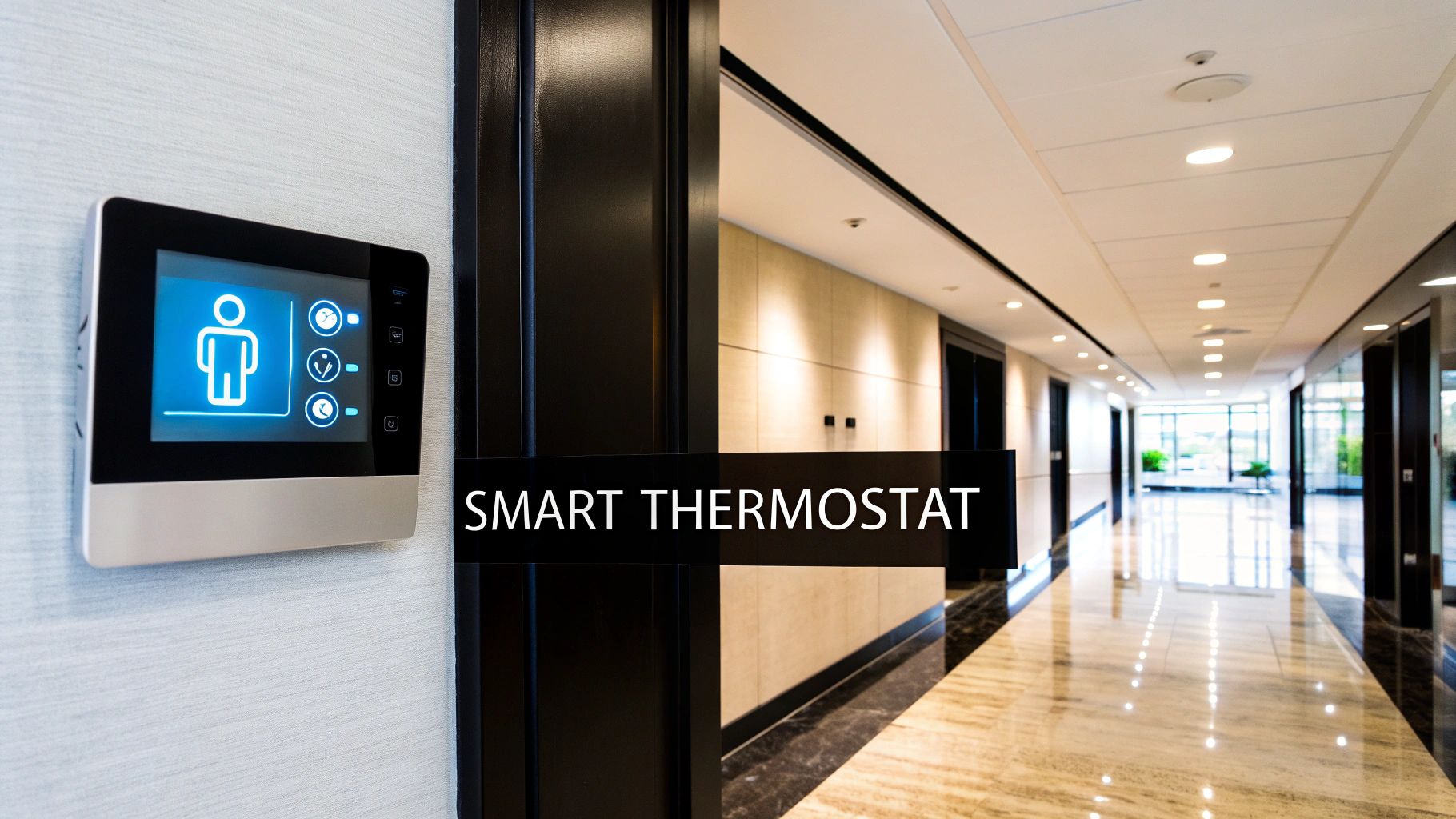
If you're looking for a smart home upgrade that delivers an immediate and noticeable impact, start with lighting. It's often the most dramatic and easiest entry point. We're not just talking about a high-tech way to flip a switch with your voice—it’s about becoming the lighting director for your own home, setting the mood for any moment with a simple tap on your phone.
Imagine this: your living room is lit with bright, cool light for focused work during the day. As evening approaches, you change it to a warm, cozy glow perfect for curling up with a book. That's the power of smart lighting. It lets you create the perfect atmosphere for a dinner party, a movie night, or just a quiet evening in. It's one of the best smart home devices to begin with because you see and feel the results instantly.
With smart bulbs and switches, you're not just illuminating a room; you're painting it with light.
Crafting the Perfect Atmosphere with Scenes
One of the coolest features you’ll get with smart lighting is the ability to create and save "scenes." Think of a scene as a lighting recipe that you can call up with a single command. Instead of fiddling with three different lamps to get the right vibe, you just say, "Alexa, start movie night."
Instantly, your overhead lights dim to 10%, the accent lights behind your TV shift to a soft blue, and the floor lamp in the corner fades to black. It's a simple phrase that triggers a perfectly coordinated, multi-step lighting change. This is what makes smart lighting so genuinely useful.
You can cook up a scene for just about anything:
- Dinner Party: Program your dining room lights to a warm, inviting hue that makes food look great and guests feel welcome.
- Focus Time: Set your office lights to a cooler, white tone that mimics natural daylight, which can help you stay alert and productive.
- Wake Up: Ditch the jarring alarm clock. Create a "sunrise" scene where your bedroom lights gradually brighten over 30 minutes, easing you into the day.
A scene is more than just a lighting setting; it's an instant mood shifter. It lets you pre-program the emotional tone of a room and recall it on demand, turning ordinary spaces into dynamic environments tailored to your life.
Beyond Bulbs: The Role of Smart Switches
While smart bulbs are fantastic for table lamps and fixtures where you want to play with color, they're not always the most practical solution. Take your kitchen, for example, which might have eight recessed ceiling lights. Swapping every single one for a smart bulb gets expensive and complicated fast.
This is where smart switches and dimmers come into play.
By replacing your standard wall switch with a smart one, you make every light connected to it "smart." Suddenly, you have remote, voice, and scheduling control over that entire bank of lights without touching a single bulb. Brands like Lutron Caséta are legendary for this, offering incredibly reliable switches that just work. For a deeper dive, check out our guide to the best smart lighting systems, which compares these different approaches.
Top Brands and What Makes Them Different
As you explore the world of smart lighting, you'll see a few names pop up again and again. Each has its own philosophy on how to best light up your home.
| Brand | Key Feature | Best For |
|---|---|---|
| Philips Hue | Unmatched range of bulb types and best-in-class color accuracy. | People who want the ultimate creative control with high-quality, vibrant colors for immersive scenes. |
| Lutron Caséta | Rock-solid reliability with a focus on smart switches and dimmers. | Homeowners who want to upgrade entire rooms, prioritizing stability and seamless control over existing fixtures. |
| Nanoleaf | Modular, artistic light panels and creative, geometric shapes. | Anyone who sees lighting as a form of interactive art and wants to create a unique visual centerpiece. |
So, how do you choose? It really boils down to what you want to achieve. Are you dreaming of painting your walls with millions of colors? Philips Hue is your go-to. Do you need a bulletproof way to control the existing lights in your kitchen and hallways? Lutron is the pro's choice. Or do you want your lighting to be a conversation starter? Nanoleaf lets you turn your wall into a canvas. Understanding these core strengths is the key to picking the system that's right for you.
Optimize Comfort and Efficiency with Smart Climate Control
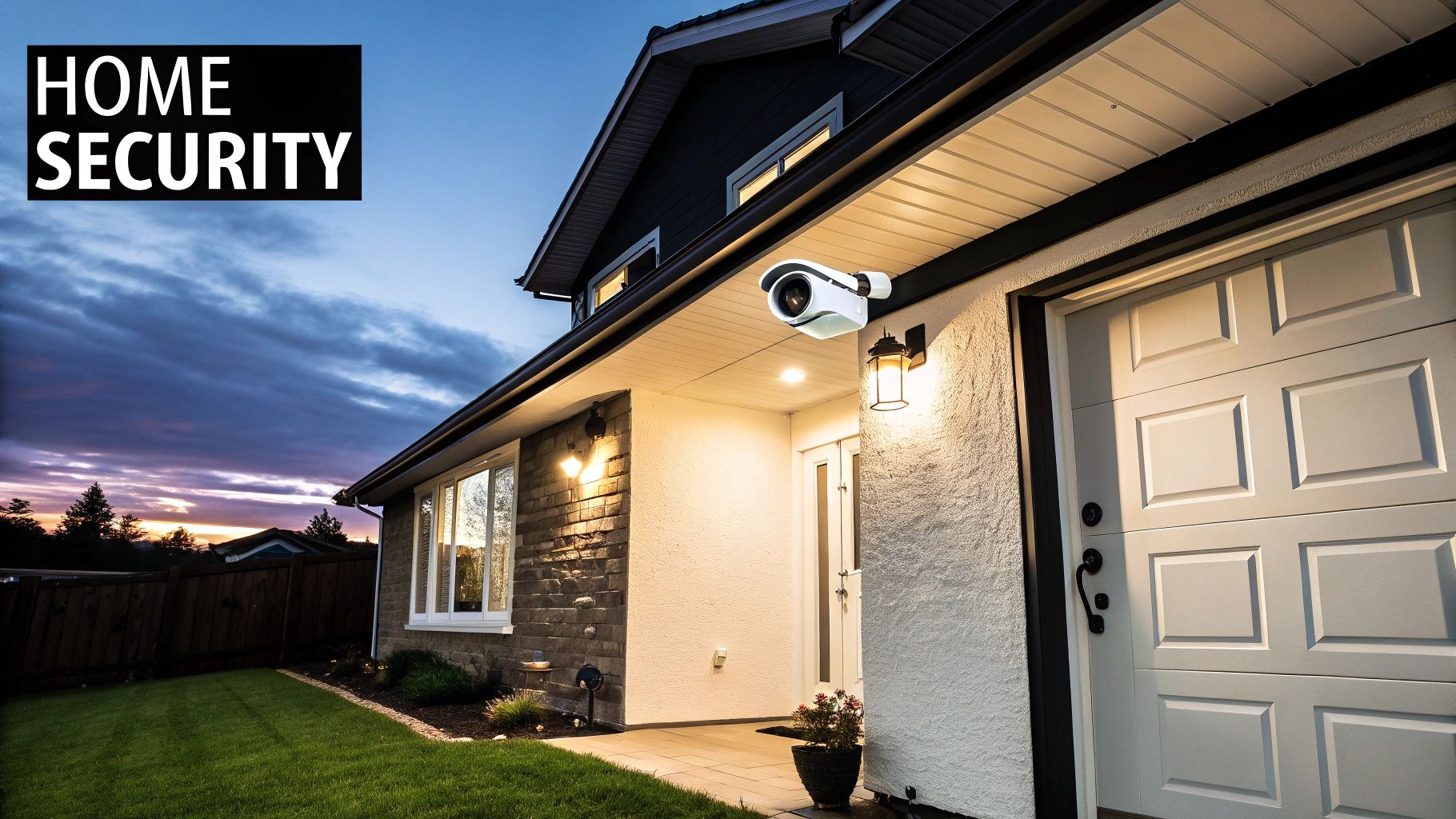
Imagine your home warming up just minutes before your alarm goes off and then dialing back to save energy the moment you head out the door. That’s not some far-off fantasy; it's the reality of smart climate control. These devices work behind the scenes, striking a perfect balance between your comfort and your wallet, which is why they’re some of the smartest investments you can make for your home.
This is where your smart home really starts to pay for itself. Instead of constantly tweaking the dial, you let intelligent automation trim your utility bills without you even noticing. The two cornerstones here are smart thermostats and their incredibly useful cousins, smart plugs.
The Smart Thermostat: A True Game Changer
Your home’s heating and cooling system is almost certainly one of its biggest energy hogs. A traditional thermostat is a pretty blunt instrument—it only knows the temperature you set it to. A smart thermostat, on the other hand, is like hiring a tiny, hyper-efficient energy manager for your house.
Take the Google Nest Learning Thermostat. Its name says it all. For the first week or so, it just watches. It learns when you turn the heat up, when you turn the A/C down, and starts to recognize your family’s rhythm.
Soon enough, it builds a custom schedule based on when you wake up, leave for work, and go to bed. It can even use your phone’s location to tell when no one’s home, automatically shifting into an energy-saving "Eco Mode." This is exactly why these devices often pay for themselves in energy savings within just a year or two.
A smart thermostat doesn’t just give you an app to control the temperature. It makes smart decisions for you. Its main job is to stop you from heating or cooling an empty house, which is one of the biggest energy-wasters there is.
Unlocking Potential with Smart Plugs
While the thermostat handles the big stuff (your central HVAC), smart plugs are the secret weapon for making nearly every other electronic device "smart." Think of a smart plug as a simple adapter that fits between an appliance’s cord and the wall outlet. Suddenly, you have on/off control and scheduling for whatever you plug into it.
This simple gadget opens up a world of possibilities for both convenience and energy savings. You can easily automate all sorts of everyday items.
Here are a few ideas:
- Morning Coffee: Plug your regular old coffee maker into a smart plug and set it to turn on at 6:55 AM. You'll wake up to the smell of fresh coffee without lifting a finger.
- Summer Comfort: Got a simple window fan? Connect it to a smart plug. Now you can turn it on from bed on a stuffy night or schedule it to circulate air without having to blast the A/C.
- Holiday Lighting: No more crawling under the Christmas tree to plug in the lights. A smart plug lets you control them with your voice or set them to turn on at sunset and off at bedtime automatically.
Finding and Eliminating Energy Vampires
Beyond making life easier, smart plugs are incredible tools for sniffing out hidden energy waste. Many of your electronics continue to draw a small amount of power even when they're "off." This is often called phantom load or vampire power, and it can add up to 10% of your monthly electricity bill.
Smart plugs are the perfect fix. By putting your entire entertainment center on a schedule that cuts the power completely overnight, you stop the phantom drain from your TV, soundbar, and game consoles. You can do the same for your home office setup, making sure monitors and printers aren't quietly sipping power all weekend. It’s a small change that leads to real savings over time.
When you put them together, smart thermostats and plugs create a powerful one-two punch for managing your home’s climate and energy use. They deliver automated comfort and real, measurable efficiency—proving that the best smart home devices are the ones that save you time, effort, and money every single day.
Unifying Your Devices with a Smart Home Hub
Having a bunch of smart devices is a great start, but getting them to work together as a single, coordinated team is where the real magic happens. This is exactly what a smart home hub does. Think of it as the central nervous system for your home, taking in commands and orchestrating a synchronized response from all your connected gadgets.
For most people, the hub isn't some extra, mysterious box. It's often the smart speaker or display already sitting on the kitchen counter. Devices like the Amazon Echo, Google Nest Hub, or Apple HomePod act as the brain of the operation, listening for your voice and translating your commands into action for your lights, locks, and thermostat.
Creating Powerful Routines and Automations
The true power of a hub comes alive when you start creating routines or automations. These are basically custom commands that trigger a whole sequence of actions across multiple devices at once. Instead of telling each device what to do one by one, you set up a single shortcut to orchestrate an entire scene.
For instance, you could create a "Goodbye" routine. With just one phrase, you kick off a chain reaction:
- The smart lock on your front door secures itself.
- All the smart lights in your home switch off.
- The smart thermostat adjusts to an energy-saving temperature.
This is how you transform a collection of separate gadgets into a cohesive system that actually responds to the rhythm of your day. The rise of voice assistants like Amazon's Alexa, Apple's Siri, and Google Assistant has made this level of control incredibly accessible. This convenience is a huge reason the U.S. smart home market is projected to grow at a CAGR of 27.19% between 2025 and 2034. You can dig into more of the data on this trend by reading the full market research.
A smart hub transforms your home from a place with cool gadgets into a responsive environment. It's the difference between having a bunch of solo musicians and having a conductor lead them in a symphony.
Understanding Zigbee and Z-Wave Hubs
While your typical smart speaker is perfect for most setups, some of the best smart home devices speak different languages, like Zigbee or Z-Wave. These are low-power wireless protocols designed specifically for smart home gear. They create a super-reliable mesh network where devices can talk directly to each other, which actually strengthens the network's signal as you add more products.
If you're planning to build a more advanced system with a wide variety of brands, you might need a dedicated hub that can speak these languages. Some premium smart speakers, like certain Amazon Echo models, have this capability built right in. For other devices, you might need a separate bridge, like the one used by Philips Hue lights. Our smart home hub comparison offers a detailed breakdown to help you pick the right central controller for your gear. This ensures that no matter what device you buy, it has a way to join the team and work seamlessly with everything else.
Got Questions About Smart Homes? We've Got Answers.
Stepping into the world of smart homes for the first time? It's normal to have a few questions. From making sure your gadgets can talk to each other to figuring out the costs, a little clarity goes a long way. Let's break down some of the most common things people ask.
Will All My Smart Home Devices Actually Work Together?
Not necessarily, and this is a big one to keep in mind. Think of it like trying to use an Apple charger for an Android phone—they're built for different systems. Most smart devices are designed to operate within a specific ecosystem, like Amazon Alexa, Google Assistant, or Apple HomeKit.
Before you buy anything, always look for a "Works with…" logo on the box or in the product description. This little badge is your guarantee that the new device will slot right into your current setup and listen to your main app or voice assistant.
Can I Really Build a Smart Home Without Breaking the Bank?
You absolutely can. Forget the idea that you have to automate your entire house overnight. The smartest way to start is small.
You can grab a single smart plug for under $20 and instantly make your old coffee maker or a living room lamp "smart." A great entry-level smart speaker like an Echo Dot often runs less than $50, giving you voice control from day one.
The trick is to focus on solving one specific problem at a time. Maybe you want a video doorbell for package security or some smart bulbs to create the perfect movie-night mood. You can add more devices over time as you see fit, which makes building a smart home a surprisingly affordable project.
The best smart home is one that grows with you. Start by solving your biggest daily annoyance, whether it's fumbling for a light switch in the dark or worrying about missed package deliveries.
By starting with a clear goal and adding new gear piece by piece, you can create a truly helpful and personalized system without that big upfront investment.
Ready to create a more connected and convenient living space? Explore in-depth reviews and expert guides at Automated Home Guide to find the perfect smart devices for your home. Visit us at https://automatedhomeguide.com.
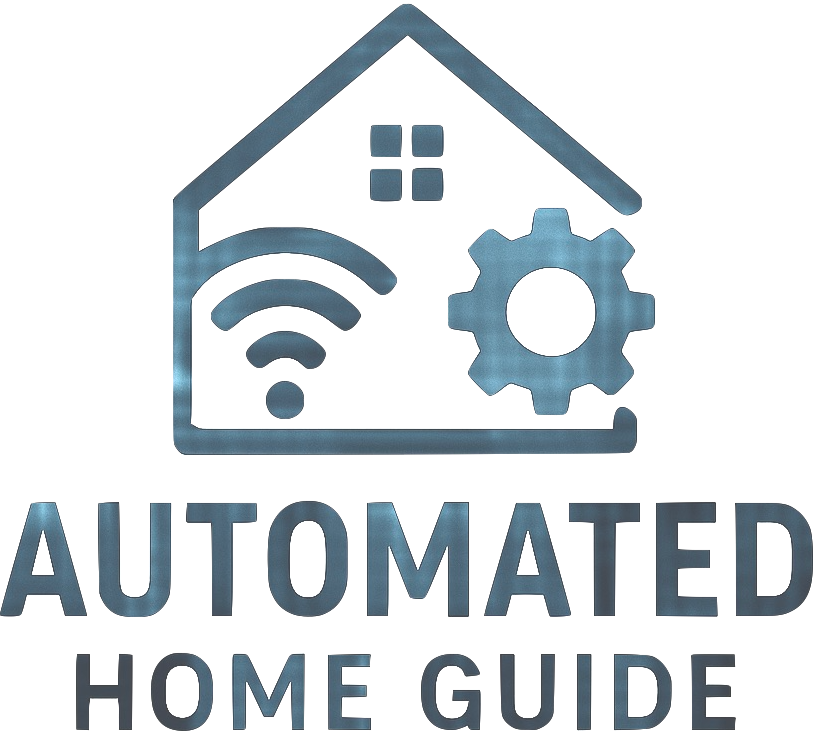
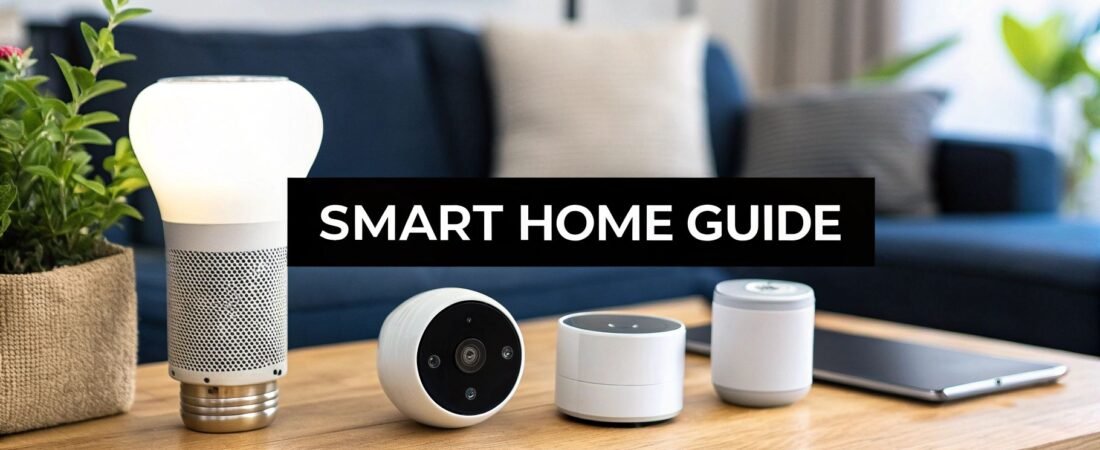
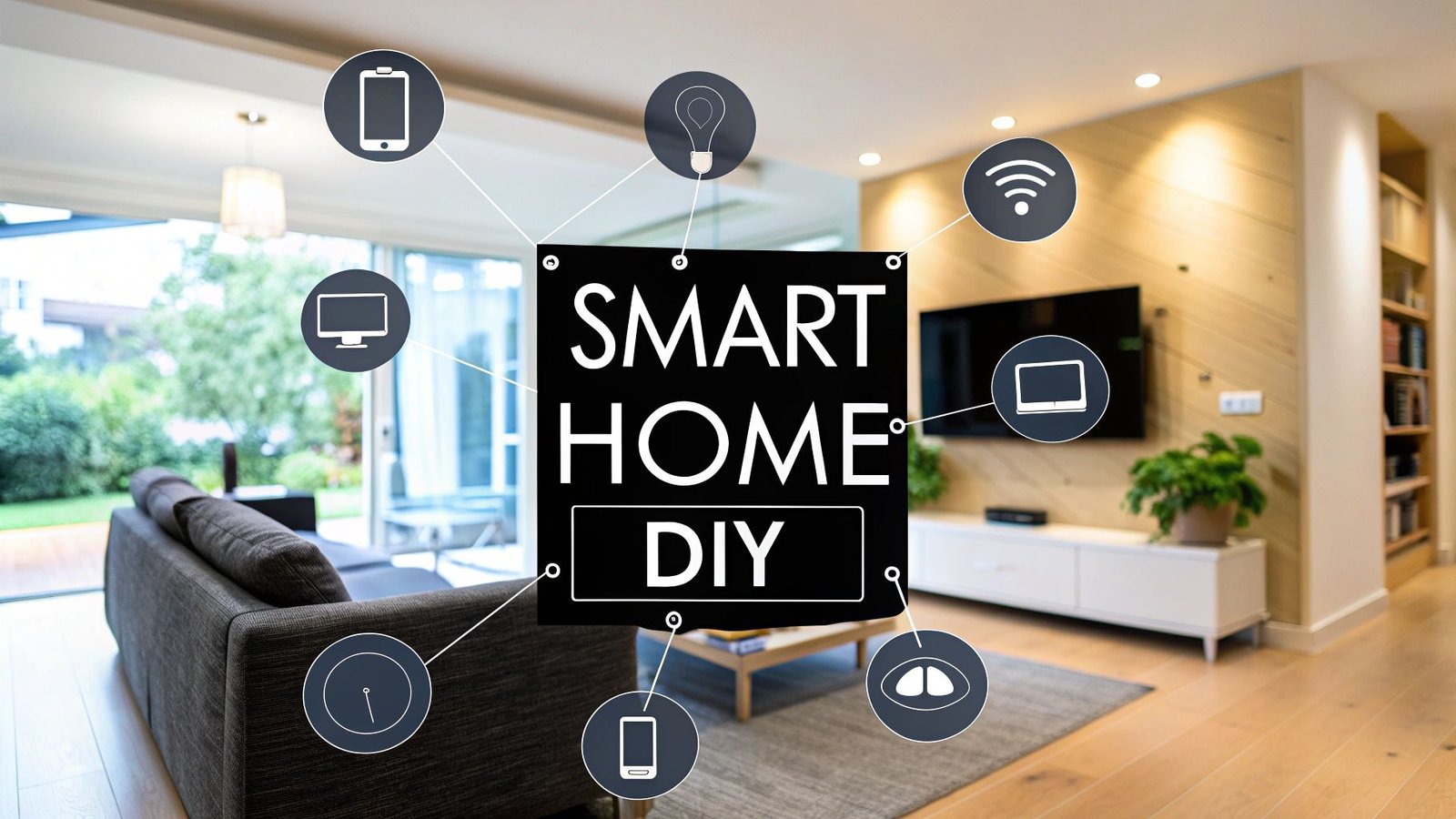
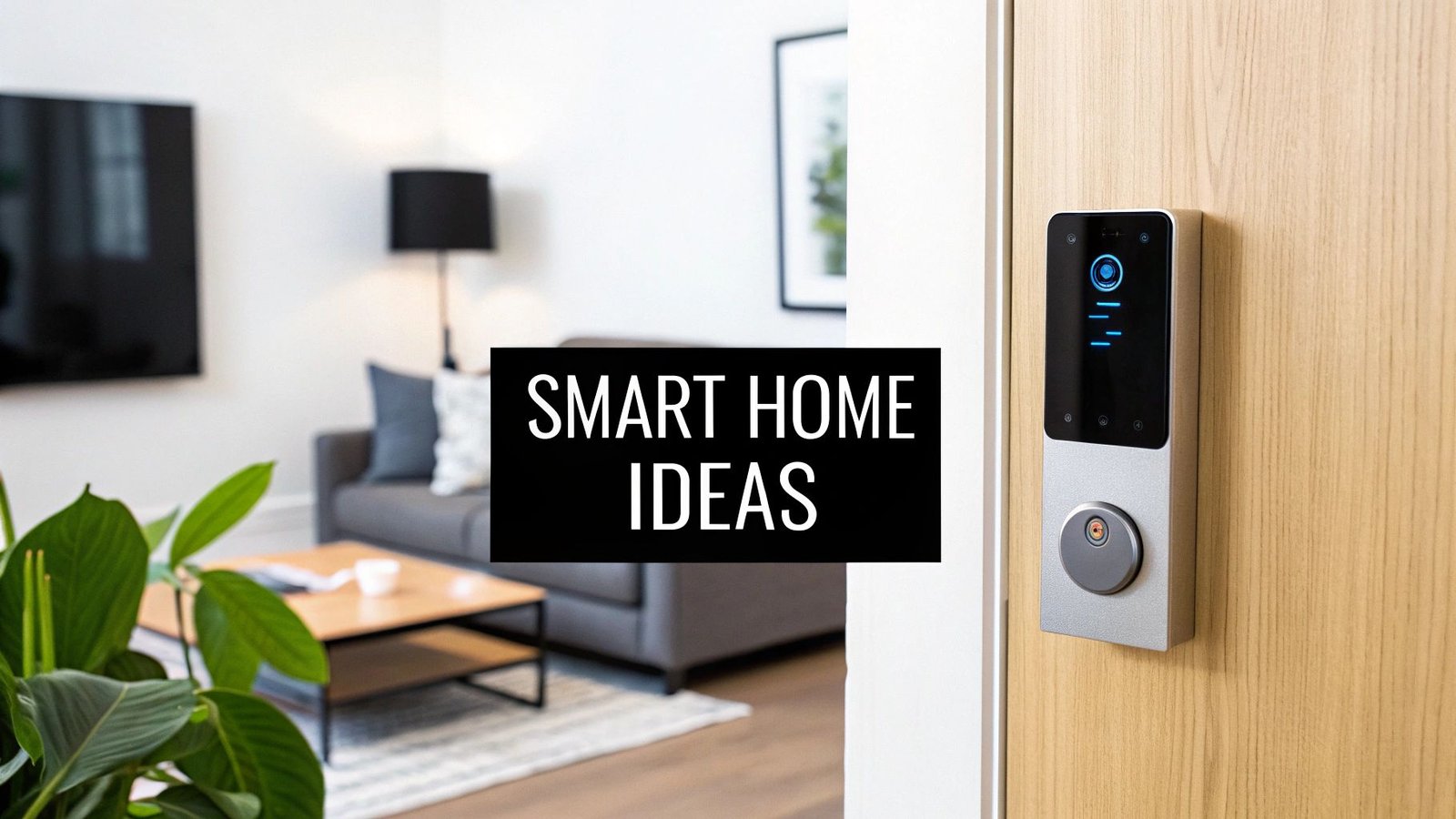

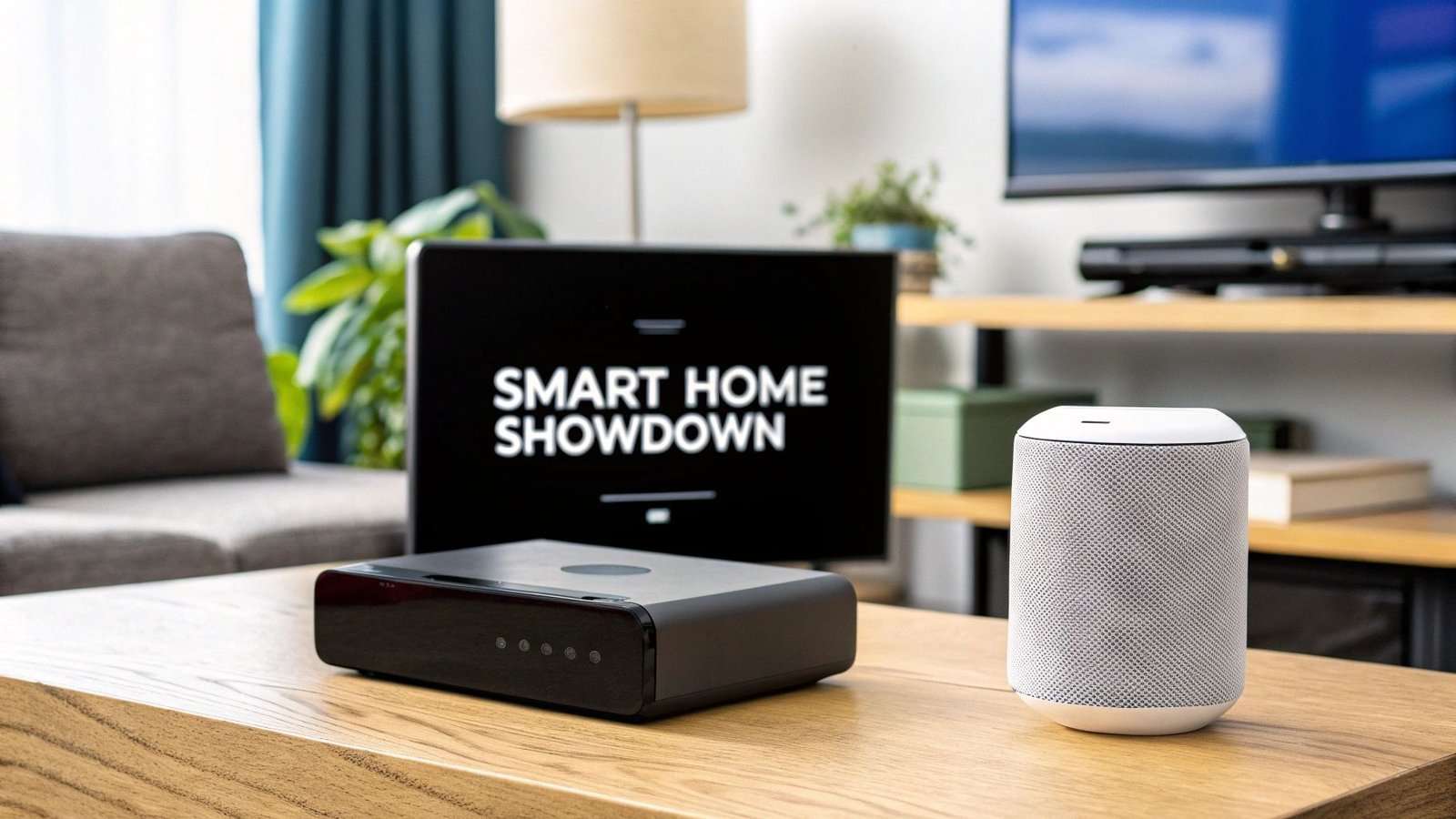


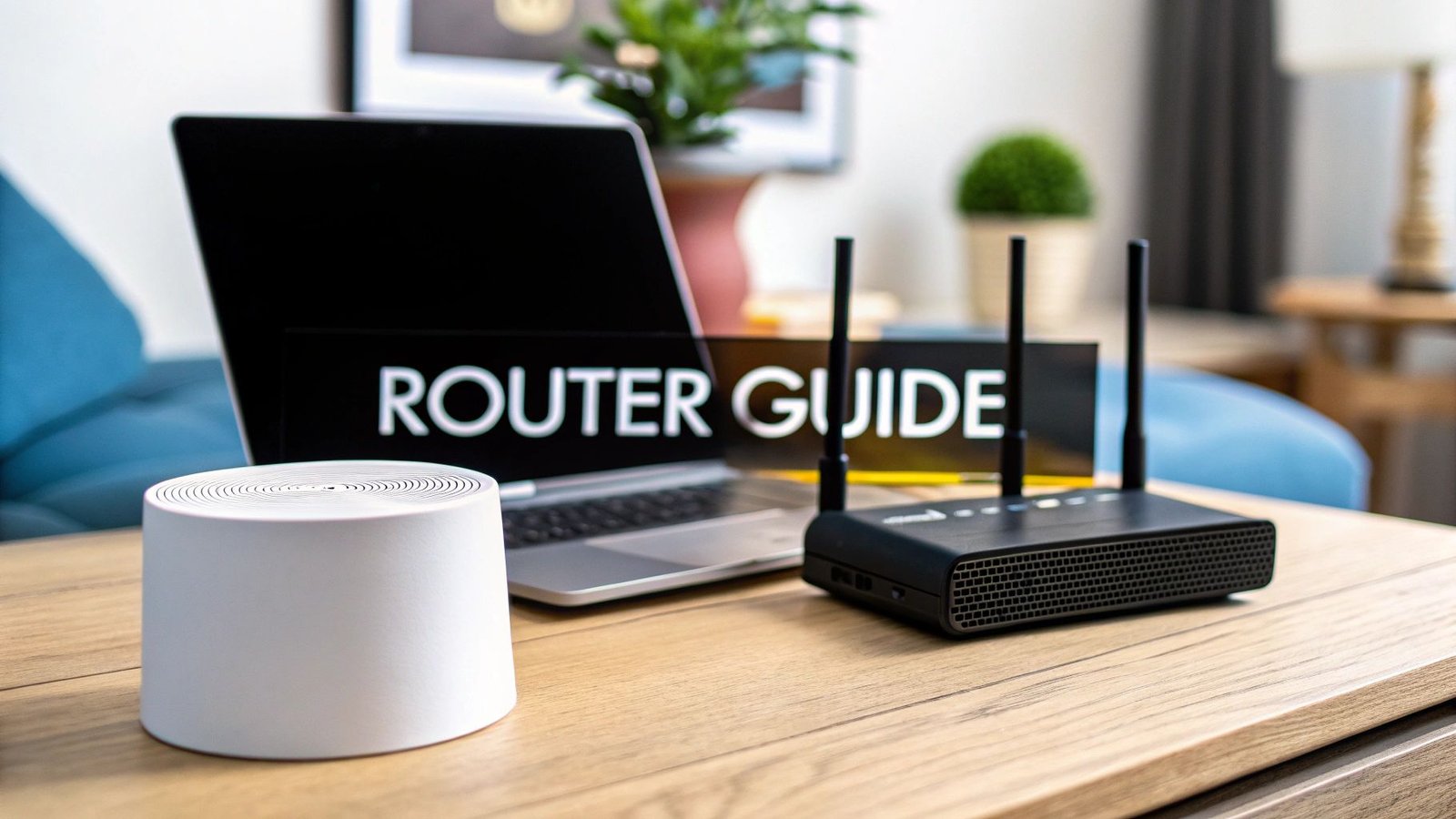
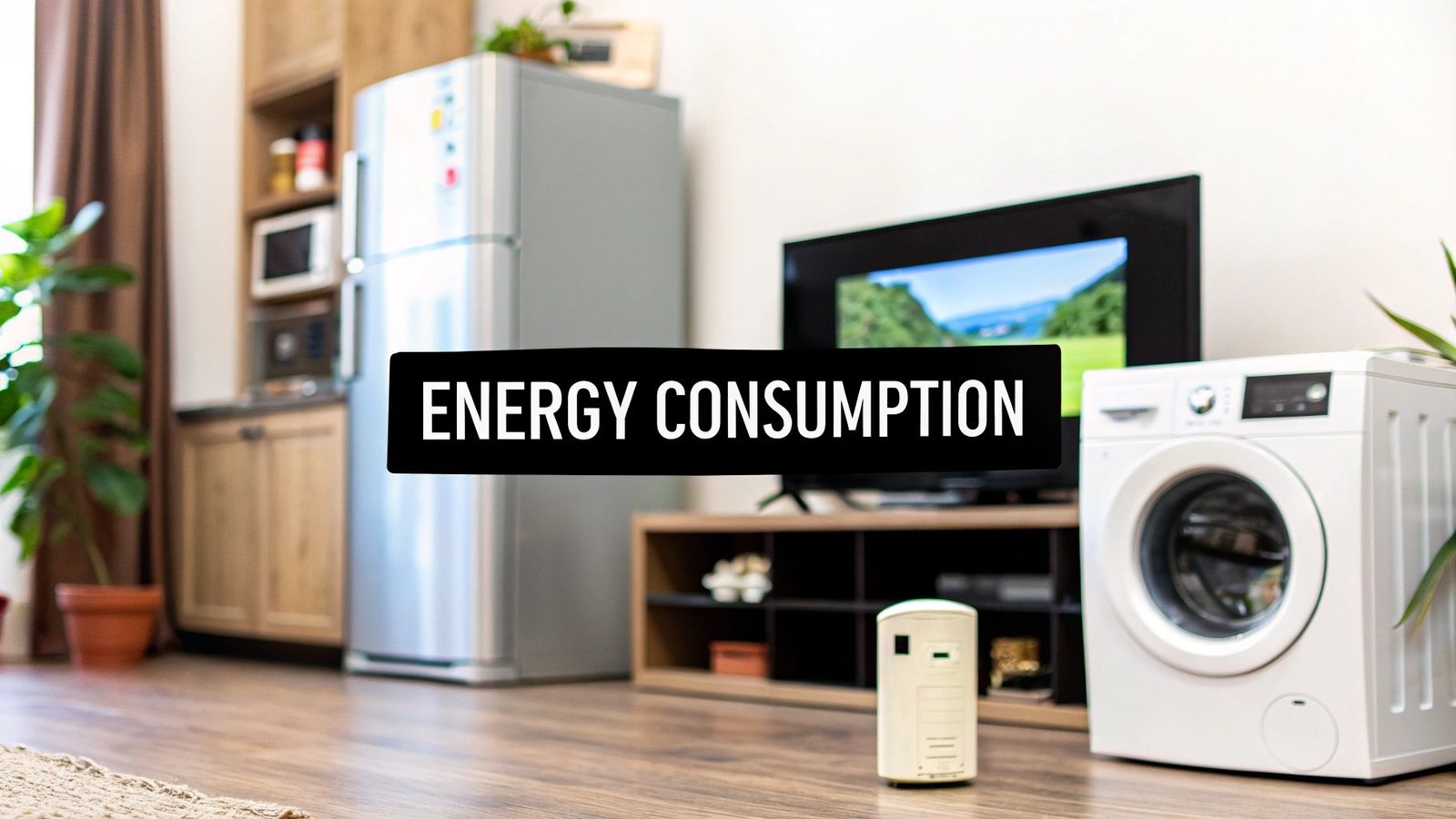
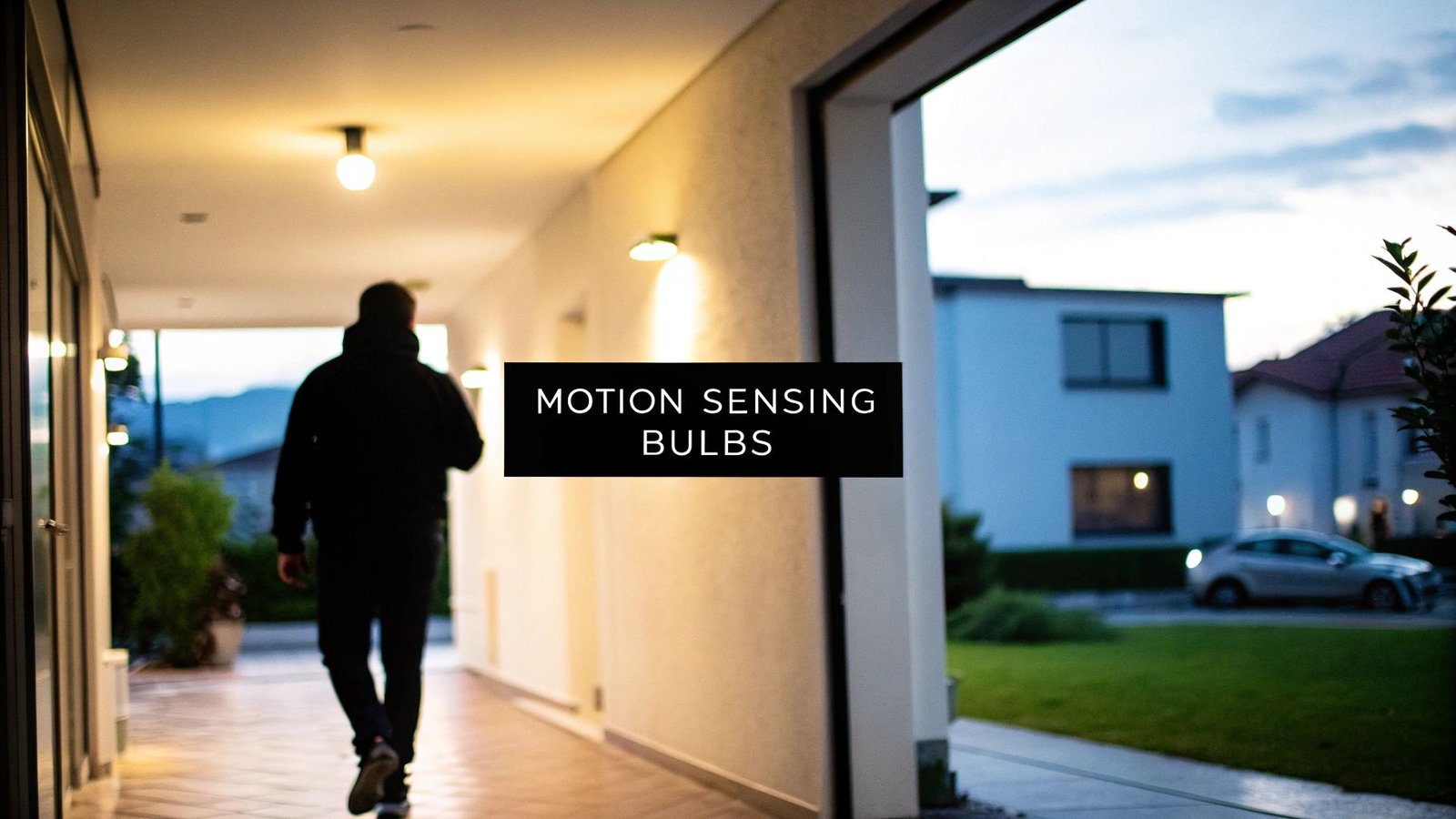
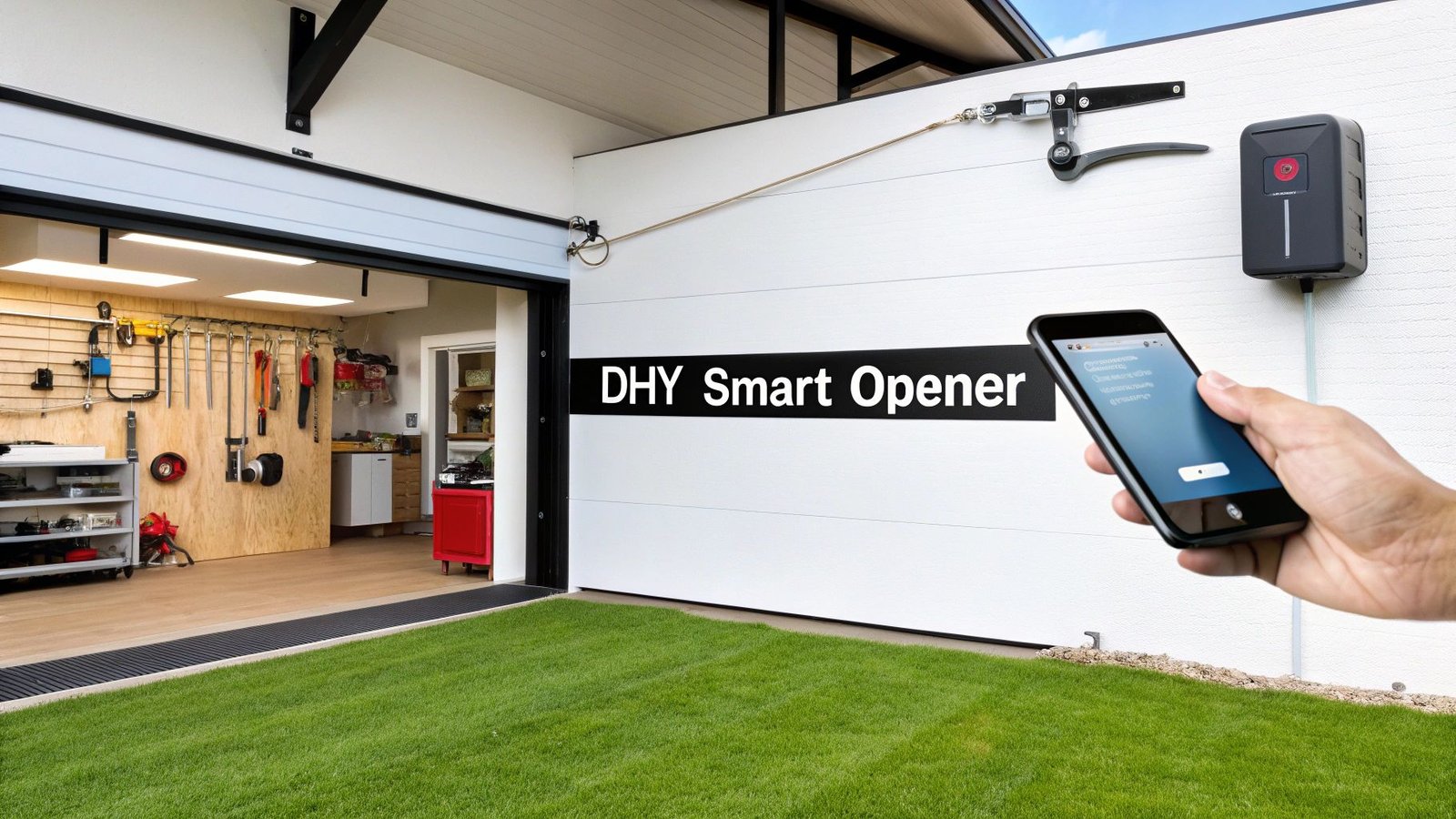
Leave a Reply